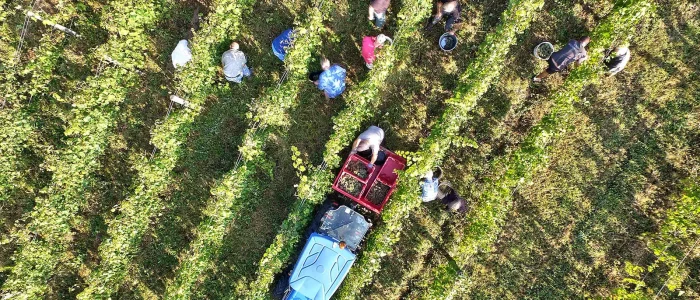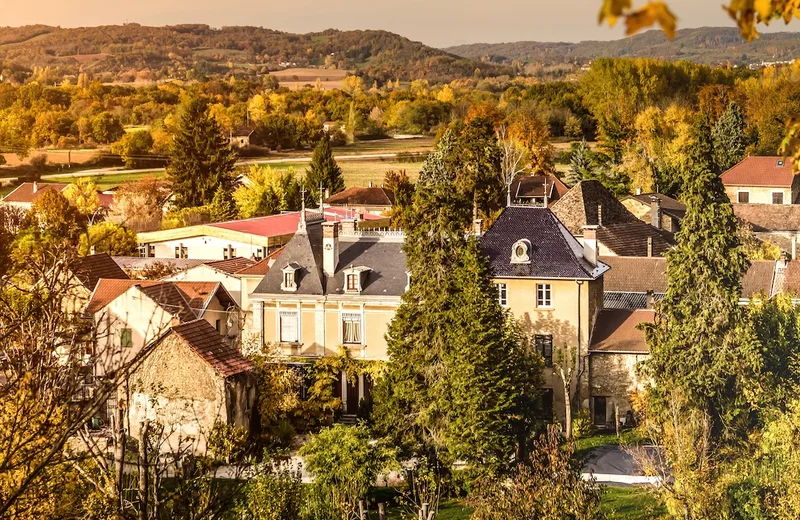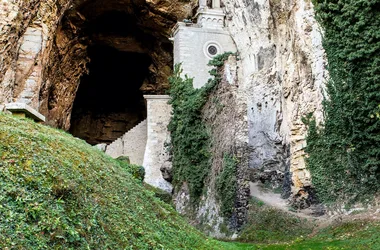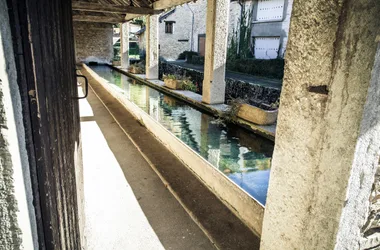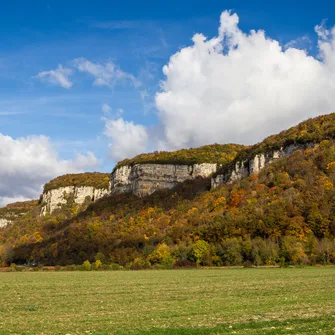La Balme-les-Grottes
Welcome to La Balme-les-Grottes, a village north of the Balcons du Dauphiné, an essential stopover on ViaRhôna. Here, heritage and nature combine, inviting you to take a journey through time, particularly through the caves and the ENS of Coteaux de Saint-Roch.
The etymology of La Balme comes from the Celtic word “balm” which means “natural cavity”.
1. La Balme-les-Grottes and its heritage (22 classified places and monuments)
– The two chapels of Notre-Dame-de-la-Balme, at the Grottes de La Balme: the first, called upper, is dedicated to the Virgin Mary and dates from the 9th century, while the second, called lower, is dedicated to Saint John the Baptist and dates from the 14th century.
– The parish church of Saint-Pierre: it offers an exceptional panorama of the surrounding area. This church is not the first to occupy this site since previously, another church, dedicated to Saint John the Baptist, stood there. Saint John the Baptist, known for his role as a purifier against evil, was chosen because of a local belief: it was said that the mysterious caves of La Balme, then little-known, sheltered evil forces.
– Salette Castle (private building): initially a Chartreusines convent founded by the Dauphin Humbert I in 1299.
This castle, which played an important role in the region, depended on the Grande Chartreuse. From the 80th century it had more than XNUMX nuns and was used greatly for the education of the younger nobles of Dauphiné. Over the centuries, the estate lost its prestige due to war and disease. Nuns also played a role in wars by training female troops. Then, under the influence of certain religious people, their lives become very precarious. During the Revolution, the estate was largely destroyed and the nuns had not been part of it for a long time.
– The Château de la Serve (private building): now almost abandoned, the main buildings date from the 1946th century. The outbuilding was reserved for the breeding of silkworms which supplied the Lyon manufacturers, testifying to the importance of this trade in the region. Following the Second World War, it served as a hostel for retired legionnaires. In 1987, Nazare Aga Kharaman Khan founded the MILE (Maison des Invalides de la Légion Etrangère) there. The legionnaires left the place definitively in XNUMX.
– Amblérieu Castle (private, cannot be visited): fortified house built at the end of the 13th or beginning of the 14th century, completed in the 16th century.
At the end of the 16th century, the area still included houses, woods, lakes and mills.
Partly destroyed by a fire on the night of August 3, 1775, the fortified house was restored by Mr. de Boulieu who built two pavilions and a large reception room.
Today, it is largely in ruins. The corner tower and the main building have disappeared.
The southern main building retains a spiral staircase tower whose door is surmounted by an armorial coat of arms.
The entrance body, to the north, retains its square tower topped with a system of machicolations.
The ruins of Amblérieu castle are listed as protected elements as Historic Monuments.
– The Château de La Balme (private): the first mention of the château dates from 1250. The estate then belonged to the dauphin Albert de la Tour.
After the sale of Dauphiné to the Kingdom of France in 1349, the castle remained the personal property of the dauphin Humbert II until his death. On the eve of the Revolution, the castle belonged to the Boulieu family.
Today there remains a tower and a few located to the south of it.
2. The Caves of La Balme, a must-see site in the Auvergne Rhône-Alpes region
The bats feel at home here! These caves are not only a geological treasure but also a remarkable historical site having served as a refuge over the centuries. The famous Louis Mandrin even found refuge there and King François I visited them in 1516 with his mother, Louise de Savoie, after the battle of Marignano.
A 19th century painting by Théodore Levigne represents the sovereign on his horse.
Today it is a flagship site of the Balcons du Dauphiné, which offers numerous activities throughout the year.
3. La Balme-les-Grottes, nature side
The Sensitive Natural Area of the Coteaux de Saint Roch*: if the cave fauna (which lives permanently in caves, underground galleries and dark and humid habitats) is very present within the caves, biodiversity is also found in the - above thanks to the Sensitive Natural Area “Les Coteaux de Saint-Roch”. Here, forests rub shoulders with meadows and dry lawns, sheltering exceptional flora. A 2,7 km marked trail allows you to discover this protected area.
4. Local personalities
– Laurent Clerc (1785-1869): Born in La Balme-les-Grottes, he became deaf following an accident in his youth.
Having joined the Institute of Deaf Mutes in Paris, he played a key role in teaching young deaf people.
His meeting with Thomas Hopkins Gallaudet was decisive: together, they founded the first school for the deaf in the United States, thus shaking up the world of education.
– Louis Chapuis, known as “Le Saharien” (1887-1944): born in Proulieu (01), Louis Chapuis, was a soldier wearing several medals. Saharan explorer guide, self-taught archaeologist, builder of bjords and Saharan trails, he lived in La Balme for part of his life. He and his team are paving the way towards the automobile conquest of the Sahara, and allowing the identification of numerous archaeological sites thanks to the clearing work.
5. The legend of the Virgin of the Caves of La Balme
Legend has it that “the sculpted Virgin [of the first chapel at the entrance to the cave] was certainly one of the most traveled in the region.
At the time of the Reformation, Protestants set up a pyre on the Place de Chavanoz to burn the Virgin of La Balme (among others), but in the meantime the Virgin had disappeared.
The story became legend and it is said that the Virgin herself escaped the events of the time by going up the Rhône.
After her return to the caves, she reappears during the Revolution, escaping a gang who also wanted to burn her.
She returned on August 15, 1794, brought back by faithful from Lagnieu.
It disappeared once again and despite orders from the State to destroy it, the town of La Balme decided to keep it.
The story ends with a final involuntary disappearance since the Virgin of the Caves was stolen in 1977!”**.
So keep your eyes peeled, because his next appearance could well be during your visit!
The town also has shops, restaurants, breweries and tourist accommodation.
*Events are regularly organized in the local ENSs. Information and registration at the Balcons du Dauphiné Tourist Office.
**MARSICO, Edigio; JUNGERS, Didier. Isle Crémieu and the Land of Colors. Edith and Me Association Edition. Earth Fortunes Collection, Edigio Marsico, ISBN 2-9520859-0-0, 11/2023
1. La Balme-les-Grottes and its heritage (22 classified places and monuments)
– The two chapels of Notre-Dame-de-la-Balme, at the Grottes de La Balme: the first, called upper, is dedicated to the Virgin Mary and dates from the 9th century, while the second, called lower, is dedicated to Saint John the Baptist and dates from the 14th century.
– The parish church of Saint-Pierre: it offers an exceptional panorama of the surrounding area. This church is not the first to occupy this site since previously, another church, dedicated to Saint John the Baptist, stood there. Saint John the Baptist, known for his role as a purifier against evil, was chosen because of a local belief: it was said that the mysterious caves of La Balme, then little-known, sheltered evil forces.
– Salette Castle (private building): initially a Chartreusines convent founded by the Dauphin Humbert I in 1299.
This castle, which played an important role in the region, depended on the Grande Chartreuse. From the 80th century it had more than XNUMX nuns and was used greatly for the education of the younger nobles of Dauphiné. Over the centuries, the estate lost its prestige due to war and disease. Nuns also played a role in wars by training female troops. Then, under the influence of certain religious people, their lives become very precarious. During the Revolution, the estate was largely destroyed and the nuns had not been part of it for a long time.
– The Château de la Serve (private building): now almost abandoned, the main buildings date from the 1946th century. The outbuilding was reserved for the breeding of silkworms which supplied the Lyon manufacturers, testifying to the importance of this trade in the region. Following the Second World War, it served as a hostel for retired legionnaires. In 1987, Nazare Aga Kharaman Khan founded the MILE (Maison des Invalides de la Légion Etrangère) there. The legionnaires left the place definitively in XNUMX.
– Amblérieu Castle (private, cannot be visited): fortified house built at the end of the 13th or beginning of the 14th century, completed in the 16th century.
At the end of the 16th century, the area still included houses, woods, lakes and mills.
Partly destroyed by a fire on the night of August 3, 1775, the fortified house was restored by Mr. de Boulieu who built two pavilions and a large reception room.
Today, it is largely in ruins. The corner tower and the main building have disappeared.
The southern main building retains a spiral staircase tower whose door is surmounted by an armorial coat of arms.
The entrance body, to the north, retains its square tower topped with a system of machicolations.
The ruins of Amblérieu castle are listed as protected elements as Historic Monuments.
– The Château de La Balme (private): the first mention of the château dates from 1250. The estate then belonged to the dauphin Albert de la Tour.
After the sale of Dauphiné to the Kingdom of France in 1349, the castle remained the personal property of the dauphin Humbert II until his death. On the eve of the Revolution, the castle belonged to the Boulieu family.
Today there remains a tower and a few located to the south of it.
2. The Caves of La Balme, a must-see site in the Auvergne Rhône-Alpes region
The bats feel at home here! These caves are not only a geological treasure but also a remarkable historical site having served as a refuge over the centuries. The famous Louis Mandrin even found refuge there and King François I visited them in 1516 with his mother, Louise de Savoie, after the battle of Marignano.
A 19th century painting by Théodore Levigne represents the sovereign on his horse.
Today it is a flagship site of the Balcons du Dauphiné, which offers numerous activities throughout the year.
3. La Balme-les-Grottes, nature side
The Sensitive Natural Area of the Coteaux de Saint Roch*: if the cave fauna (which lives permanently in caves, underground galleries and dark and humid habitats) is very present within the caves, biodiversity is also found in the - above thanks to the Sensitive Natural Area “Les Coteaux de Saint-Roch”. Here, forests rub shoulders with meadows and dry lawns, sheltering exceptional flora. A 2,7 km marked trail allows you to discover this protected area.
4. Local personalities
– Laurent Clerc (1785-1869): Born in La Balme-les-Grottes, he became deaf following an accident in his youth.
Having joined the Institute of Deaf Mutes in Paris, he played a key role in teaching young deaf people.
His meeting with Thomas Hopkins Gallaudet was decisive: together, they founded the first school for the deaf in the United States, thus shaking up the world of education.
– Louis Chapuis, known as “Le Saharien” (1887-1944): born in Proulieu (01), Louis Chapuis, was a soldier wearing several medals. Saharan explorer guide, self-taught archaeologist, builder of bjords and Saharan trails, he lived in La Balme for part of his life. He and his team are paving the way towards the automobile conquest of the Sahara, and allowing the identification of numerous archaeological sites thanks to the clearing work.
5. The legend of the Virgin of the Caves of La Balme
Legend has it that “the sculpted Virgin [of the first chapel at the entrance to the cave] was certainly one of the most traveled in the region.
At the time of the Reformation, Protestants set up a pyre on the Place de Chavanoz to burn the Virgin of La Balme (among others), but in the meantime the Virgin had disappeared.
The story became legend and it is said that the Virgin herself escaped the events of the time by going up the Rhône.
After her return to the caves, she reappears during the Revolution, escaping a gang who also wanted to burn her.
She returned on August 15, 1794, brought back by faithful from Lagnieu.
It disappeared once again and despite orders from the State to destroy it, the town of La Balme decided to keep it.
The story ends with a final involuntary disappearance since the Virgin of the Caves was stolen in 1977!”**.
So keep your eyes peeled, because his next appearance could well be during your visit!
The town also has shops, restaurants, breweries and tourist accommodation.
*Events are regularly organized in the local ENSs. Information and registration at the Balcons du Dauphiné Tourist Office.
**MARSICO, Edigio; JUNGERS, Didier. Isle Crémieu and the Land of Colors. Edith and Me Association Edition. Earth Fortunes Collection, Edigio Marsico, ISBN 2-9520859-0-0, 11/2023
Themes:
Visit
Individual visit services
- Unguided individual tours permanently
Opening
| Opening hours from January 01 to December 31, 2024 | |
|---|---|
| Monday | Open |
| Tuesday | Open |
| Wednesday | Open |
| Thursday | Open |
| Friday | Open |
| Saturday | Open |
| Sunday | Open |
Prices
Free access.
Services
Equipments
Linked offers
On the spot…
